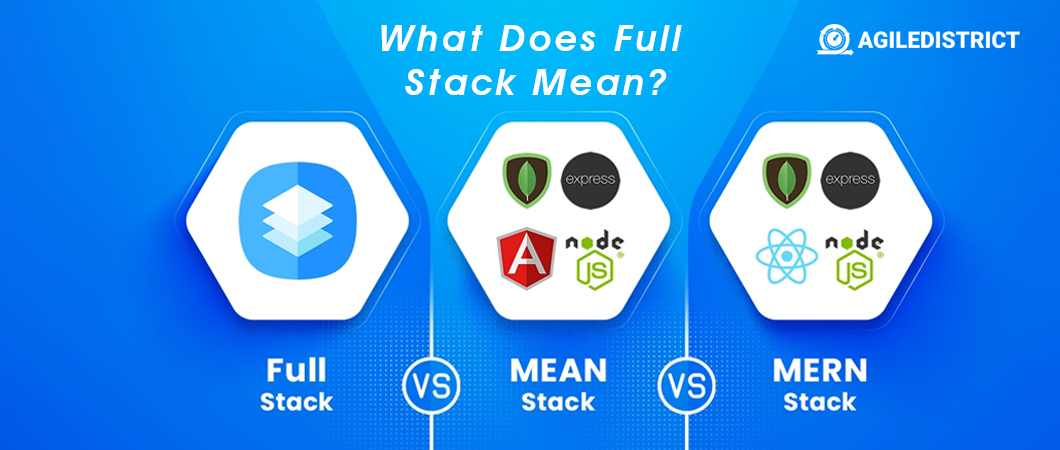Breaking Down Front-End and Back-End: The Two Pillars of Full Stack
To grasp the idea behind full stack, it’s helpful to look at its two main components. The front-end includes what users interact with—buttons, forms, and design elements built using HTML, CSS, and JavaScript. The back-end manages data, server logic, and APIs. Together, these create the digital experience. A developer familiar with both ends can ensure smooth communication between the visual and functional layers. At Agile District, our approach ensures every aspect of your product—from design to deployment—is tightly integrated, providing a seamless experience for end-users and technical teams alike.
What Makes a Developer ‘Full Stack’?
A developer with full stack skills can shift between user interface design and server-side scripting effortlessly. But more than a jack-of-all-trades, this developer understands how each part of an application influences the other. They might design a layout in React, then connect it to a Node.js backend with a MongoDB database. This broad expertise reduces the need for hand-offs and encourages faster development. At Agile District, we prioritize hiring talent with this holistic skill set, ensuring that our teams can handle diverse project needs efficiently and with high quality from start to finish.
How Full Stack Differs from MEAN Stack
Though often used interchangeably, full stack and MEAN stack aren’t the same. Full stack is a general term for developers skilled in both front-end and back-end work using any technology stack. MEAN, by contrast, is a specific collection of tools—MongoDB, Express.js, Angular, and Node.js—that create a unified JavaScript environment. So, while every MEAN stack developer is full stack, not every full stack developer uses MEAN. At Agile District, we choose between these options based on your project’s unique requirements, leveraging the best tools to ensure top performance and scalability.
Popular Technologies in Full Stack Development
A full stack solution integrates a mix of technologies. On the front end, languages like JavaScript and frameworks such as Angular or React are common. On the back end, tools like Node.js or Python power logic and data handling. Databases range from SQL to NoSQL systems like MongoDB—often featured in MEAN stack projects. These technologies interact to deliver a cohesive user experience. Agile District’s developers stay current with evolving tech trends to ensure our clients get modern, efficient, and reliable web applications, tailored to their specific business needs.
Why Agile District Prefers Full Stack Development
At Agile District, we often recommend full stack development because it accelerates timelines, improves consistency, and lowers costs. With developers capable of managing both interfaces and infrastructure, we streamline the entire workflow. This reduces friction in communication and simplifies troubleshooting. Clients benefit from a unified approach where each component is crafted with the bigger picture in mind. Whether building an MVP or scaling an enterprise app, full stack development enables us to deliver complete solutions, customized to your goals. It’s an efficient model that supports rapid innovation without sacrificing quality.
The Real-World Benefits of Hiring Full Stack Developers
From startups to large enterprises, hiring a developer with broad skills can be a game-changer. These professionals can manage design, development, and deployment—all in one go. This reduces the overhead of maintaining separate teams and fosters a more integrated workflow. At Agile District, our cross-functional teams use this approach to deliver faster results with fewer roadblocks. Whether it’s updating a user interface or optimizing a database query, our full stack pros can handle it. This adaptability makes them a valuable asset to any project aiming for speed, efficiency, and quality.
The Rise of MEAN Stack and Its Role in Modern Projects
The MEAN stack has become a favorite for modern web development due to its unified use of JavaScript. This stack simplifies the development process, especially for real-time and single-page applications. MongoDB handles data storage, Express.js and Node.js manage the server-side logic, and Angular delivers a dynamic front-end. At Agile District, we use MEAN when projects benefit from fast execution and consistent coding practices. Because it uses a single language across the stack, MEAN also improves developer productivity and reduces errors—making it a smart choice for scalable, maintainable solutions.
Full Stack Development Myths – Busted!
There’s a misconception that full stack developers are generalists lacking depth. In truth, many possess deep knowledge in both interface design and backend systems. Another myth is that full stack is only suitable for small apps. That’s simply false—many large-scale applications benefit from the flexibility and speed this approach offers. At Agile District, we’ve successfully implemented full stack strategies across industries, proving its scalability and effectiveness. By debunking these myths, we help businesses recognize the strategic advantages of working with professionals who see—and shape—the entire project ecosystem.
How Agile District Delivers Smart Full Stack Solutions
We believe smart technology begins with smart development. At Agile District, full stack is more than a capability—it’s our core strength. Whether using a custom setup or a popular stack like MEAN, we adapt our approach to suit your project’s unique needs. Our developers collaborate closely across every layer, ensuring nothing is overlooked. From concept to code to launch, we manage it all under one roof. This tight integration means better performance, faster iterations, and more reliable outcomes. If you want software built for both beauty and brains, our full stack approach is the way to go.
